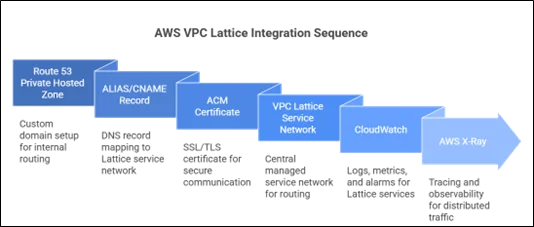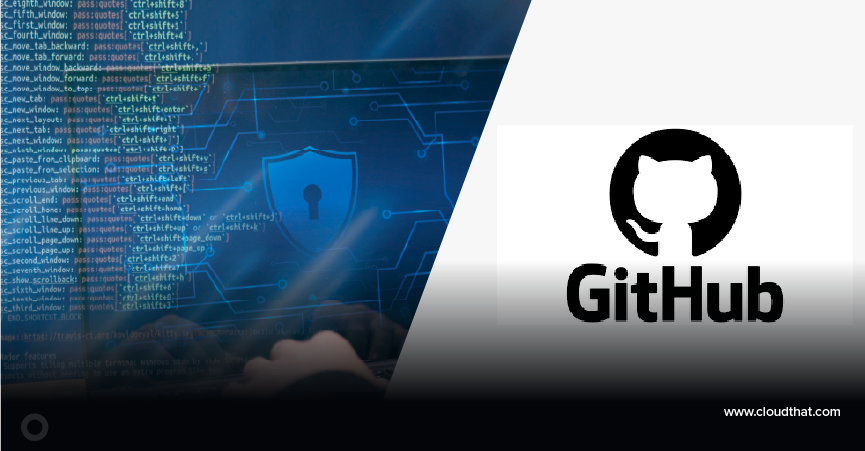|
Voiced by Amazon Polly |
Introduction
Amazon VPC Lattice has rapidly emerged as a cornerstone for application networking on AWS, revolutionizing how cloud engineers, DevOps professionals, and architects connect, secure, and monitor services at scale. Moving beyond the patchwork of service-to-service networking solutions, such as Amazon VPC Peering, AWS PrivateLink, and legacy service meshes, Amazon VPC Lattice introduces a managed, unified approach that allows organizations to streamline connectivity both within and across AWS accounts and VPCs, regardless of the compute platform.
By consolidating service discovery, routing, and access controls under a single service network, Lattice minimizes the operational overhead that often slows cloud adoption. Organizations can now design microservice architecture without worrying about IP conflicts, multiple peering arrangements, or managing complex DNS solutions.
Pioneers in Cloud Consulting & Migration Services
- Reduced infrastructural costs
- Accelerated application deployment
Understanding Amazon VPC Lattice
Amazon VPC Lattice is a fully managed application networking service that abstracts much of the underlying network complexity. Teams can define security, connectivity, and traffic management policies once and apply them consistently across all environments.
Amazon VPC Lattice also automatically handles scaling, failover, and cross-VPC discovery, making it suitable for multi-account, hybrid, or global deployments.
Key Architecture and Concepts

- Service Networks: Logical groupings that define which services can communicate. These simplify discovery, isolate workloads securely, and allow consistent policy enforcement across all accounts and regions.
- Services: Individual application endpoints (HTTP, HTTPS, gRPC, TCP), each backed by target groups like Amazon EC2 instances, containers, or Lambda functions.
- Listeners & Rules: Specify ports, protocols, and routing behaviors, including advanced patterns like blue/green or canary deployments. Rules can perform path-based or hostname-based routing, request weighting, and failover, ensuring high availability and granular control over traffic.
- Resource Gateways & Endpoints: Connect Amazon VPC Lattice services to other AWS resources, databases, or on-premises systems while maintaining security, NAT control, and optional IPv4/IPv6 configurations.
Integration: Amazon ECS, Amazon EKS, AWS Lambda, and Cross-Account
- Amazon ECS/Amazon EKS: Both integrate natively with Lattice. Services register as targets in a service network. Multi-cluster Kubernetes workloads can communicate across accounts without custom peering, DNS hacks, or additional networking appliances. For ECS, an Application Load Balancer in front of the services ensures smooth traffic routing and observability.
- AWS Lambda: Functions can serve as target groups for services, supporting event-driven architectures or backend APIs. Lattice allows these functions to communicate directly with other compute types across accounts.

This diagram illustrates how VPC Lattice enables cross-account connectivity.
Secure traffic flow and DNS resolution using Amazon Route 53, with enforced security and identity policies.
- Cross-Account: Lattice service networks can span multiple AWS accounts, enabling fine-grained segmentation and security without IP overlap or complex route tables. AWS IAM integration ensures consistent identity-based access, while policies remain centralized and auditable.
Security and Traffic Management
- Authentication and Authorization: Leverage AWS IAM and resource-based policies to enforce identity-aware access. Only authorized services or users can communicate.
- Encryption: All traffic is encrypted by default. Custom AWS KMS keys can be used for additional compliance requirements.
- Advanced Routing: Supports both HTTP-level and TCP-level routing, with path-based rules, failover, and request weighting. Progressive deployments, such as blue/green or canary, can be implemented without the need for additional service proxies.
Monitoring and Cost Considerations

This diagram illustrates how custom domains are managed with Route 53 and ACM certificates in VPC Lattice, as well as how CloudWatch and AWS X-Ray provide end-to-end monitoring and tracing capabilities.
Amazon VPC Lattice integrates tightly with Amazon CloudWatch for metrics, logs, and tracing, offering visibility into service health, traffic patterns, response times, and policy enforcement.
Cost model:
• Hourly charges per provisioned service
• Charges per GB of data processed
• Per-request or connection fee for HTTP/TCP listeners
• Optional charges for enhanced monitoring, extended log retention, or custom metrics
Organizations should evaluate usage patterns and scaling strategies, as high-volume deployments may see significant incremental costs.
Real-World Use Cases and Scenarios
Example 1: Multi-Cluster Microservices with ECS, Lambda, and RDS
A fintech company connects multiple Amazon ECS clusters across accounts, integrates Lambda APIs, and accesses a centralized Amazon RDS instance-all via Lattice. Policies enforce least-privilege access, and Amazon CloudWatch dashboards provide end-to-end observability.
Example 2: Amazon EKS Service Mesh Replacement
As traditional service mesh solutions are phased out, many teams are migrating to Amazon VPC Lattice. Service networks mirror cluster boundaries (dev, staging, prod), and authentication policies enforce secure communication without running sidecars or custom controllers.
Example 3: Hybrid Cloud Application
On-premises applications connect to AWS-hosted services via AWS Direct Connect, which is attached to Lattice endpoints. IAM-based policies secure traffic, and centralized dashboards provide performance insights and operational visibility.
Pros and Cons

Modern AWS Networking: Where VPC Lattice Fits
Amazon VPC Lattice is quickly becoming AWS’s default for service-to-service networking, especially as App Mesh phases out. For new microservices, serverless-first apps, or highly secure environments, Lattice provides consistent connectivity, security, and observability without route management, peering, or network appliances.
Conclusion
Teams should prototype migration for existing service meshes, use Lattice for all new cross-account or multi-cluster applications, and monitor usage to optimize cost and performance.
Amazon VPC Lattice is more than an incremental improvement-it’s a foundational leap in AWS networking, enabling agility, security, and operational visibility for distributed, multi-account, and hybrid cloud environments.
Drop a query if you have any questions regarding Amazon VPC Lattice and we will get back to you quickly.
Making IT Networks Enterprise-ready – Cloud Management Services
- Accelerated cloud migration
- End-to-end view of the cloud environment
About CloudThat
CloudThat is an award-winning company and the first in India to offer cloud training and consulting services worldwide. As a Microsoft Solutions Partner, AWS Advanced Tier Training Partner, and Google Cloud Platform Partner, CloudThat has empowered over 850,000 professionals through 600+ cloud certifications winning global recognition for its training excellence including 20 MCT Trainers in Microsoft’s Global Top 100 and an impressive 12 awards in the last 8 years. CloudThat specializes in Cloud Migration, Data Platforms, DevOps, IoT, and cutting-edge technologies like Gen AI & AI/ML. It has delivered over 500 consulting projects for 250+ organizations in 30+ countries as it continues to empower professionals and enterprises to thrive in the digital-first world.
FAQs
1. What makes Amazon VPC Lattice different from traditional networking options like VPC Peering or PrivateLink?
ANS: – Amazon VPC Lattice provides a unified, managed framework for service-to-service connectivity across multiple VPCs and accounts, eliminating the complexity of managing peering links, overlapping IP addresses, or custom DNS configurations. It centralizes routing, access control, and observability under one service.
2. How does Amazon VPC Lattice enhance security and governance for microservices?
ANS: – Amazon VPC Lattice integrates with AWS IAM for identity-based authentication and authorization, ensuring only approved services or users can communicate. All traffic is encrypted by default, and granular policies can be applied at the service or network level, enabling a true Zero Trust model.
3. Which workloads benefit most from adopting Amazon VPC Lattice?
ANS: – Amazon VPC Lattice is ideal for organizations running distributed workloads on Amazon ECS, Amazon EKS, AWS Lambda, or hybrid environments. It simplifies cross-account and multi-cluster communication, replaces traditional service meshes, and provides consistent networking and monitoring for microservices at scale.

WRITTEN BY Sana Pathan
Sana Pathan is the Head of Infra, Security & Migrations at CloudThat and also leads the Managed Services and FinOps verticals. She holds 7x AWS and Azure certifications, spanning professional and specialty levels, demonstrating deep expertise across multiple cloud domains. With extensive experience delivering solutions for customers in diverse industries, Sana has been instrumental in driving successful cloud migrations, implementing advanced security frameworks, and optimizing cloud costs through FinOps practices. By combining technical excellence with transparent communication and a customer-centric approach, she ensures organizations achieve secure, efficient, and cost-effective cloud adoption and operations.


 Login
Login


 October 16, 2025
October 16, 2025 PREV
PREV










Comments